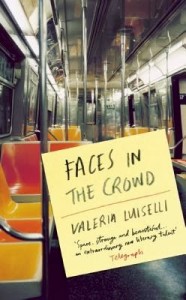
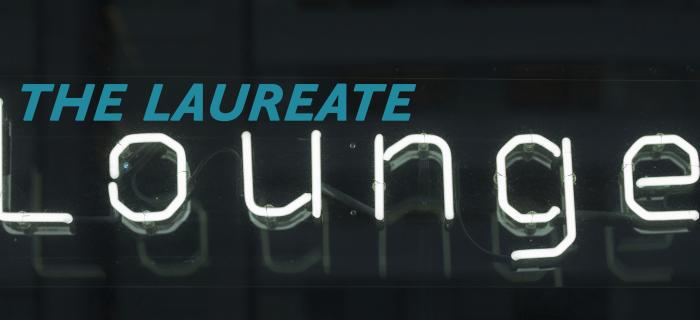 Editor’s note: Today’s arts world is a shifting one. Arts organizations are moving from traditional (and sometimes elitist) modes of art presentation to more collaborative, grass-roots, and innovative ways of engagement. One of the organizations I admire that is addressing this shift in a very successful and intriguing way is Coffee House Press. I asked CHP publisher Chris Fischbach and independent curator Sarah Schultz some questions about the changing arts ecosystem and their recent collaboration, The Laureate Lounge, with (and at) the American Swedish Institute (ASI). The Laureate Lounge is “an inventive space inspired by the real and imagined habits of Nobel Laureates” where participants dig into their own creativity by completing short exercises created by four writers and artists (Rachel Jendrzejewski, Janaki Ranpura, Sun Yung Shin, and Andy Sturdevant). The exhibit is part of the larger Nobel exhibit at ASI, and goes through May 24. Today, I’m sharing part one of my discussion with Chris and Sarah (part two will be on the blog next week).
Editor’s note: Today’s arts world is a shifting one. Arts organizations are moving from traditional (and sometimes elitist) modes of art presentation to more collaborative, grass-roots, and innovative ways of engagement. One of the organizations I admire that is addressing this shift in a very successful and intriguing way is Coffee House Press. I asked CHP publisher Chris Fischbach and independent curator Sarah Schultz some questions about the changing arts ecosystem and their recent collaboration, The Laureate Lounge, with (and at) the American Swedish Institute (ASI). The Laureate Lounge is “an inventive space inspired by the real and imagined habits of Nobel Laureates” where participants dig into their own creativity by completing short exercises created by four writers and artists (Rachel Jendrzejewski, Janaki Ranpura, Sun Yung Shin, and Andy Sturdevant). The exhibit is part of the larger Nobel exhibit at ASI, and goes through May 24. Today, I’m sharing part one of my discussion with Chris and Sarah (part two will be on the blog next week).
Hazel & Wren: Can you talk about how this partnership with the American Swedish Institute came together?
Chris Fischbach: About a year ago, Coffee House placed poet Ed Bok Lee in residence in ASI’s library, as part of our CHP: In the Stacks library residency program. Not knowing Swedish, but drawing on context, he created a series of “metatranslations” of poems he found in the archive. On top of that, a number of one-minute films were created that in turn translated those poems onto screen. The ASI even fashioned a whole exhibit around this project.
Having felt that that collaboration was a success, when an opening came up to create an exhibit for the larger Nobel exhibition, they decided they wanted to have one based on the Nobel Prize for Literature. So, naturally, they thought of us.
H&W: How did you select your four writers/artists for the Laureate Lounge?
Sarah Schultz: Our main goal in creating the Laureate Lounge was to introduce audiences to the diversity of creative work and practices by Nobel prize winning authors and to inspire them to create something themselves.
The Nobel Prize is a big deal. It is the largest and most prestigious award in the world. Your chances of winning one are pretty slim even if you are already a highly accomplished writer. Imagine your chances if you aren’t! Chris and I had a lot of fun trying to figure out how an average person might actually go about winning one. What were the secrets of the prize-winners in literature? How did they manage to write that book? Come up with that idea? Stick to it for so long? Chris and I talked about writers we thought would be interested in using the work of other writers for as inspiration. I worked with Rachel Jendrzejewski last summer at the Walker as part of Open Field and knew that she was really skilled at writing in ways that prompt participation. I’ve been a fan of Janaki Rampura’s work for a while. So this was a great opportunity to work with her.
CF: We wanted writers we knew that would be interested in crafting a piece that somehow would enable visitors to participate, rather than just create something to read or to look at. I’ve worked closely with Andy and Sun Yung before, and knew they would get it, and Sarah had worked with Rachel and Janaki in her former role at the Walker Art Center.
H&W: What kind of experiences/thoughts do you hope the audience takes away from the Laureate Lounge?
CF: That literature is something that can be experienced in ways other than just reading. That reading isn’t necessarily a passive experience, but that it’s always participatory—this exhibit makes enacts that literally.
SS: I hope that people are reminded about the many ways they are creative in their own lives. I also hope that they are motivated to read the work of some of the authors. I know that was inspired to read the work by the Swedish writer Selma Lagerlof, who won the Nobel Prize in 1909. I hadn’t heard of her before this project.
H&W: Chris, I found a quote of yours on the CHP blog where you said that CHP has been “transforming from being solely a publisher to becoming a cultural organization that produces both books and programming,” as two ways to reach your audience. What have been your guiding principals through this transition at Coffee House Press? Who comes up with the programming ideas?
CF: Another way that we put it is that we provide “nontraditional ways of accessing the reading experience.” I’d add “writing experience” to that as well.
Our goal is to connect writers and readers. Publishing books is the historical and primary way we achieve our goal, but it’s not the only way. Programming, residencies, experiences, we’re open to it all. It’s about creating different kinds of spaces for both writers and readers to encounter, enact, absorb, create literature. To demystify it. To find new ways for writers to put their skills to work that is outside of the book paradigm.
We want our books and writers to be catalysts for new art. And we want them to be available to other people and organizations to help them achieve their goals, or fulfill their missions.
As for who comes up with the programs, it’s usually a group effort. It’s true that I sometimes get credit for the whole “Books in Action” initiative, but it’s really about having a great team that’s all on board, coming up with ideas together. And it’s also about being very willing to sit down with new partners and collaborators and brainstorm. Sarah is my favorite person to do that with.
H&W: Sarah, I’m interested to hear how you approach working with so many different organizations as a freelance curator. Do you immerse yourself in their mission/past work, or do you try to focus on the future of what you are curating with them?
SS: Context is always the most critical part of curating or designing any project. I start by looking at what we might build from within the organization and how we can be responsive to the local community and situation. Then, I try to stretch what is possible or even sensible. I learned this from working with so many creative people on Open Field at the Walker. I am super collaborative and like to toss around ideas even if they are ridiculous…actually, especially if they are a far-fetched and a little uncomfortable. It helps move you beyond what you already know. It is always exciting to walk into a new situation and be surprised by what is possible working together.
Working with Chris, the artists and the team at ASI was inspiring and fun. We came up with scores of project ideas. It’s always challenging to have to choose between great ideas. The ASI staff was very inventive in helping us pack a lot of activity into a small space!
Psst: Stay tuned for Part 2 of this interview next week!
What We’re Reading: The Little Free Library Book

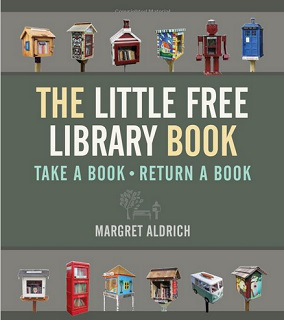 The Little Free Library Book by Margret Aldrich (Coffee House Press, 2015)
The Little Free Library Book by Margret Aldrich (Coffee House Press, 2015)
First of all, happy AWP 2015 Conference, dear writers and readers! If you are partaking in the national writer’s conference based here in our very own Minneapolis, I wish you merry liter-nerdy adventures galore! In honor of the celebratory spirit of a nation of writers converging, I decided to do a BONUS review today. And I’m featuring one of my all-time favorite publishers who just so happens to also be based in this grand city of Minneapolis: Coffee House Press. This book, The Little Free Library Book, is something entirely unique and exciting to read. My partner and I recently had an offer accepted on our first house, and shortly after, I read this book. Let me tell you: it has me VERY excited to build my own Little Free Library (LFL) as soon as we move in!
For those of you unfamiliar with these little gems, they are libraries that folks put in their front lawns (mostly, although people have been known to get very creative!). They typically look like little houses, although again, people get innovative with their libraries. They operate on a “take a book, leave a book” philosophy, and in that way, are always changing. Founder Todd Bol (of nearby Hudson, WI) says about them, “It engages and brings neighborhoods together, and folks talk to each other more than they ever have.”
The Little Free Library Book has pictures galore for inspiration, how-to instructions for those looking to start their own LFL, and first hand experiences from Aldrich herself, as well as from founder Todd Bol, and from LFL stewards around the world (yes, world!). The format of the book, with it’s combined use of Aldrich’s narrative, first-hand testimonials, how-to’s, and photos, makes me think about this new generation of nonfiction books. I’ve noticed a trend that this type of nonfiction intermingles the typical nonfiction prose with photos, how-to blurbs, and additional nuggets. It makes books like this easy to engage with. (Yet, part of me wonders, is this what our society of short attention spans is turning to? I’m not saying this as a criticism; I truly loved The Little Free Library Book. But it is an interesting question to ponder.)
The great thing about these LFLs is that people are encouraged to make them their own. Some people use them for seed exchanges with their neighbors, in addition to book sharing. Others use them to distribute their own poetry or comics, or ask for passers-by to write their own poems and leave them for someone else. There are even some that turn the roofs of their LFLs into a garden itself. The possibilities are endless!
Because these LFL give so much freedom to their stewards for creation, the LFLs themselves become pieces of art. LFL stewards have used recycled material in making their libraries, in addition to bike parts, buttons, flower gardens, old suitcases, and pinball machines. Some folks have even built LFLs with their neighbors, a true piece of community art. (But don’t worry for those of you who don’t feel the need to create a work of art from scratch: you can buy LFLs online, or ask others to make them for you, too.)
The libraries are meant to encourage literacy, and many of them specifically cater to children, such as the LFL of Nancy Vogl and David Strange of Traverse City, Michigan:
“We built our Little Free Library, specifically for children only, as a way to reinforce the importance of reading,” Vogl says. “We see way too many young people with their heads down looking at electronic devices, and we don’t want them to lose the magic of holding a book in their hands.”
Other low-income communities are building little free libraries as a way for kids to have access to books. Sure, literacy is a lofty goal, but its one that LFLs aren’t afraid to tackle head-on in their own small but significant way, one book at a time.
Yet others have different goals, such as to put poetry in the streets (and off the lofty pedestal people tend to put it on). Poet Billy Collins is even quoted in the book on this subject:
“I’m all for poetry in public places, poetry released from the confines of the library and the classroom, poetry that enters the mainstream of American life. […]
The Little Free Library is a terrific example of placing books—poetry included—within reach of people in the course of their everyday lives. […] Here’s hoping we bump into literature when we turn the next corner—before we have time to resist!”
What struck me the most about this little grassroots literacy campaign is its humble yet undeniable ability to build community within a city block (and beyond, in many cases). In a world where it’s perfectly acceptable to not know every person on your block, creating something to be shared with your fellow neighbors is something special. In my graduate school classes on creative communities, we talk about a community’s “bump factor”, aka, how often people in that community are apt to “bump into” other people and discuss, share, engage. If a community’s bump factor is high, it’s more likely to be a creative community with a strong cultural identity. Now, the bump factor is just one of many factors that play into community building, but it’s one that the Little Free Library does well.
Two LFL stewards, Ellen and Col Cseke of Canada, describes a surprising “bump” encounter they’ve had because of their LFL:
Late one night, Ellen was standing outside the front door looking for her keys. From behind her she heard a gruff voice calling, “Hey, hey you, excuse me.” She saw a rather rough-looking guy standing on the sidewalk and nervousness went through her body; it was dark and no one else was out. Then the gentleman asked, “Hey, I have a ton of books—if the Library is too full, can I leave a box beside it with the extras that don’t fit?”
This element of the unexpected connection with someone you might typically not have interacted with voluntarily is just one part of the magic that is a LFL.
Another unique facet of LFL that caught my attention was their interactivity, and how they encourage people to cross boundaries (you literally have to step over a boundary and into someone else’s yard to check out a LFL). This crossing of boundaries not only increases the chance bump factor, but also creates connections, and encourages participants to get to know each other (as in, who left that book?).
I’ll close with a rallying cry as a LFL-convert: In the name of community building, boundary crossing, and grassroots literacy for the people, check out the next Little Free Library you come across. And hey, maybe like me, you’ll even be tempted to build one for your own community. Happy reading, and sharing, folks.
Do you have a Little Free Library, and if so, what have some of your most interesting experiences with it been? Can you think of other literacy campaigns that pull together communities like this?
What We’re Reading: Faces in the Crowd

Faces in the Crowd by Valeria Luiselli (Coffee House Press, 2014)
A mother in contemporary Mexico City writes a novel about her past. A young translator living in New York City, obsessed with the poet Gilberto Owen, finds traces of him in Harlem and on the subway. Owen loses weight, loses sight, and is slowly disappearing in 1950s Philadelphia, dreaming of his past and his prime in New York City.
Luiselli’s first novel (translated by Christina MacSweeney) tells a story of love and loss. Her writing blurs the line between life and death across three narratives that overlap in content and time, leaving much up for the reader to accept or dismiss as reality.
We read the novel that the unnamed (and unreliable) narrator in Mexico City is writing about her youth in New York. We are introduced to the eclectic acquaintances who pass through her otherwise nearly empty apartment with keys she’s given away. We watch her follow the Gilberto Owen’s past and convince her boss at a small publishing house to publish translations of Owen’s poems.
As she writes in Mexico City, she claims the novel is a “horizontal novel, told vertically”, or perhaps a “vertical novel told horizontally”; she tells her young son it’s a ghost story. Her husband asks questions about the book, revealing that she has imagined some pieces of her past, leaving it to the reader to decide what to believe is fact or fiction, who is a ghost or who is a living memory.
Eventually, Gilberto Owen joins as a narrator, and while he’s disappearing in Philadelphia, he’s remembering his past in New York City, He sees a young woman with sad, tired eyes, often on a subway train running momentarily parallel to his. Then one speeds up, and they’re no longer locked in synchronicity. This image is repeated from the perspectives of both Owen and the young translator, who impossibly meet each other at the same time and place.
The narrator reflects:
The subway, its multiple stops, its breakdowns, its sudden accelerations, its dark zones, could function as the space-time scheme for this other novel.
The stories and memories span nearly 100 years and take place in New York, Philadelphia, and Mexico City for all narrators, unhinging the reality of time and place that we understand. If you’re able to let go of that reality and follow the story the way it wants to be told, you’ll fall into the pages and believe the connections between people—ghosts or not—to be true.
At times I had to re-read pages to be sure I knew who was speaking, and most importantly, when they were speaking. Luiselli crafts her narrations to flow so seamlessly together that sometimes the last word spoken by one will be the first spoken by the next. Certain objects reoccur in many scenes, from the narrator’s red coat that Owen catches her in, to the dead tree he left in his Morningside apartment that she later discovers and attempts to revive.
The female narrator lives with the dead tree at her writing table. Based on the narratives overlapping in different time periods, you might start to believe the unreliable narrator when she says she’s writing a ghost story. She happens to find comfort in death:
In a way, I was living in a perpetual state of communion with the dead. But not in a sordid sense. In contrast, the people around me were sordid… The dead and I, no. I had read Quevedo and internalized, like a prayer, perhaps too literally, the idea of living in conversation with the dead. I often visited a small graveyard a few blocks from my apartment, because I could read and think there without anyone or anything disturbing me.
The narratives inch closer and closer together, until they meet in the same present, which was satisfying after feeling them slowly connect, piece by piece. Through the carefully crafted sentences that make up each intriguing shift in narration, the novel ends up telling just one story (where space and time are irrelevant): a story about poetry, mortality, memory, and about writing a story, the themes of which appear slowly—then all at once—in each perspective.
How does a story change when time and place are no longer relevant? When reading a novel with unreliable and shifting narrators, what can you gleam as “truth” for the story, when in our reality it’s all truly fiction?
What We’re Reading: Summer Preview Round-Up
 With summer waving its lilac blossoms and punchy-green budding branches at us, we’re getting ready for a summer of reading. The local Minnesota presses have enough to offer without me even needing to look further; but please, add to this list. If you have a book you’re looking forward to, tell us about it! To start this off, here’s a list of books I’m excited to read by the side of a lake, on the sun porch, or while enjoying a brewski.
With summer waving its lilac blossoms and punchy-green budding branches at us, we’re getting ready for a summer of reading. The local Minnesota presses have enough to offer without me even needing to look further; but please, add to this list. If you have a book you’re looking forward to, tell us about it! To start this off, here’s a list of books I’m excited to read by the side of a lake, on the sun porch, or while enjoying a brewski.
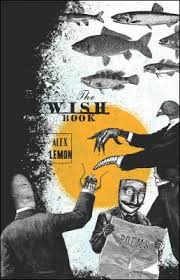 The Wish Book by Alex Lemon (Poetry, Milkweed Editions)
The Wish Book by Alex Lemon (Poetry, Milkweed Editions)
I was floored by Lemon’s poetry collection Fancy Beasts, so can’t wait to dig into this romp of a book. If the cover art is indicative at all of the interior, this is going to be an absolute pleasure of the senses, and will be rife with his pop culture observations and striking approach.
The Search by Geoff Dyer (Novel, Graywolf Press)
You may have noticed my recent obsession with excellent literary crime fiction, which is why it’s no surprise that The Search has been added to my list. Publisher’s Weekly described the book as “A take on the detective / noir genre in the vein of Auster, Calvino, and Borges. . . . Dyer creates a series of puzzles, which are sure to send some back for a second read”. A fan of Calvino, I’m looking forward to getting lost in Dyer’s puzzling display of mystery and storytelling.
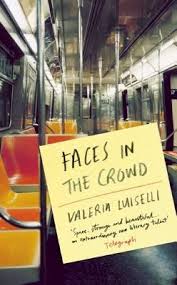 Faces in the Crowd by Valeria Luiselli (Novel, Coffee House Press)
Faces in the Crowd by Valeria Luiselli (Novel, Coffee House Press)
Layered novels captivate me with their patient story arches, the weaving of characters and time. I expect Faces in the Crowd to be no different. With three narrators struggling with voices and memories of the past, I’m excited to see how Luiselli brings their individual voices together for the overarching thread.
Thirty Rooms to Hide In by Luke Longstreet Sullivan (Memoir, U of M Press)
Six sons of a prominent Mayo Clinic surgeon watch their father go insane and turn to abuse in this dramatic family history. Families and their inner factions fascinate me, and hearing Sullivan’s account of his childhood is sure to capture my attention.
What are you looking forward to reading? Are you trying to catch up on things you’ve started, or are you ready to start something new?
